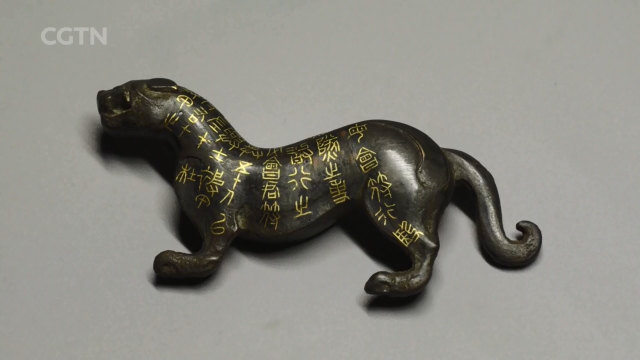
10:52, 01-Jun-2018
If Treasures Could Talk: Tiger Seal the power to command armies in your hand
05:11

We continue with our series "If Treasures Could Talk", showcasing some of China's most valuable ancient treasures. Come with us today to see the Tiger Seal, with which, you may have the power to command armies in your hand.
This figure of a tiger lying quietly looks like it could have been made in modern times. Its true identity is revealed by the ancient calligraphy inlaid in gold. This is a tiger seal.
A tiger seal represented the king, and so embodied the power to command armies. Two thousand years ago, Wei Wuji , a prince of Wei, risked his life to obtain one. With the Qin army surrounding its capital, it seemed the State of Zhao was about to fall. If so, Wei would be attacked next. Yet the king of Wei refused to send for help, fearing retaliation from Qin. Wei Wuji decided he could aid Zhao by stealing the Qin king's tiger seal. He succeeded, and using the seal he raised an army to save Zhao. Wei was safe for now. The fate of states was decided by a tiger seal.
Only three tiger seals are known to still be in existence: The Yanglin seal, the Du seal, and the Xinqi seal.
The longest inscription is found on the Du tiger seal, housed at Shaanxi History Museum. Roughly translated, the inscription reads: "This is the seal of armies. The right seal is held by the king, the left seal by the garrison commander". A general could only move his army if the king brought the right seal to the garrison and united it with the left seal.
During the Warring States Period, cities and land were constantly changing hands. Kings used their tiger seals to convey their orders.
They were inscribed with hidden designs, which served as the "passwords" of their day. The two halves of a seal, one carried by the king and the other by a general, had a matching design on their back. Only when two matching parts of a seal were brought together could an army be dispatched.
Another means by which orders were transmitted was through passes known as jie. The bronze jies of E Junqi, housed at Anhui Museum, granted the bearer tax-free passage.
The inscriptions tell us that in 323 BC, King Huai of Chu gave these jie to his son, E Junqi. One jie was for ships and the other for carriages. They were only valid when two pieces were united. With time, seals like these disappeared from use. But not the principle they embody. Two thousand years later, we still use various forms of verification to protect our security.

SITEMAP
Copyright © 2018 CGTN. Beijing ICP prepared NO.16065310-3
Copyright © 2018 CGTN. Beijing ICP prepared NO.16065310-3